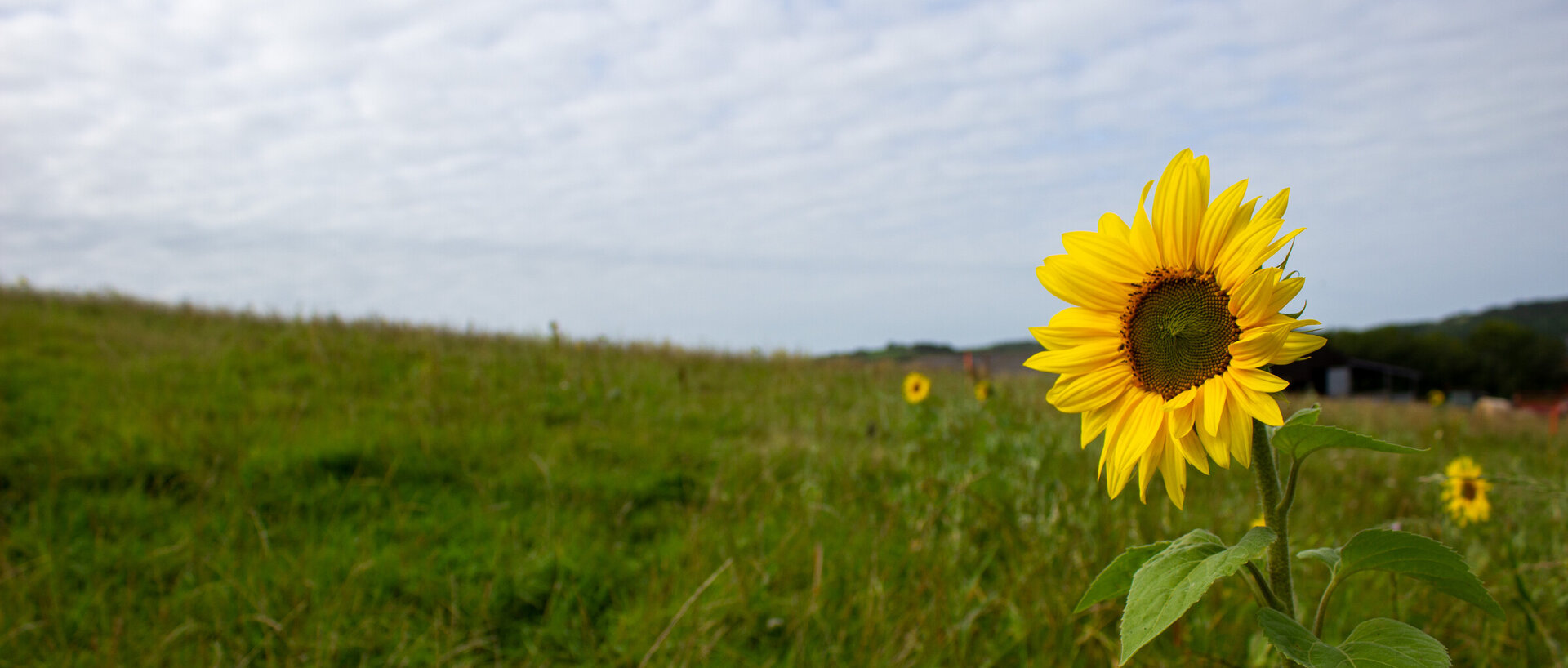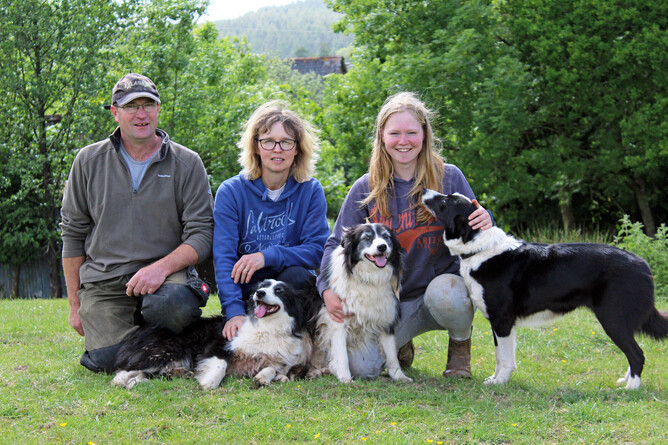Redwoods Farm is located in Mid Devon, close to the Somerset border and for a lowland farm, sits quite high at up to 850 feet above sea level. It came into the family in 2007 when it was purchased by my parents, Mark & Pauline Chapple. Here I’ll explain how they moved from contemporary, more intensive farming to regenerative agriculture methods.
Changing life on the farm
Whilst Mid Devon is known for its red soils, Redwoods itself does not enjoy such fertile ground. It is more of a stoney clay loam, rather than the easy working, fertile red soil further down the valley.
Mark and Pauline began to question the expensive inputs they were using to keep the farm productive. They realised fertilisers, herbicides and purchased cereals for feeding sheep and cattle were not always economic and weren't benefiting the environment. Through talking with farmers around the world on farming internet forums and finding like-minded people in the industry, they started to change their system into a forage based one. While experimenting with different grazing management strategies, they discovered that farming can benefit the environment. They decided they wanted to find ways to work with nature, rather than exploiting it.
Regenerative agriculture
Visiting the Groundswell conference in 2019 accelerated the pace of change towards regenerative agriculture. Listening to how many different speakers have interpreted the universal principles of regenerative agriculture created a bigger picture of how a regenerative system could work on Redwoods Farm.
We began to create grazing plans for cattle, sheep and pigs, ensuring the grassland had longer to recover. This meant forage could provide all the nutrition required by our cattle and sheep as they are ruminants, with a digestive system suited to extracting all their requirements from the pasture. However, pigs and poultry are omnivores like ourselves and need a more varied diet which may include naturally foraged insects, slugs, worms as well as additional grains. We are working to source the required grain from local farms using no or minimal till cropping. You'll be able to read more about no till cropping in our regenerative agriculture blogs in future.
Indoor to outdoor sheep husbandry
Mark and Pauline began with an indoor lambing system with Mule and Suffolk cross sheep. However, the continual struggle with parasitic worms becoming resistant to treatments caused them to look into alternative breeds with more natural resistance. In 2011 they began their change of breed, originally trying Highlander, Lleyn, New Zealand Texel and New Zealand Romney. These breeds are all suited to an outdoor lambing system, which created a lower workload, allowing my parents to have a larger flock of sheep. Eventually they decided to settle for the Highlander sheep, due to its maternal instincts and good worm resistance. This breed, with its ability to grow well on pasture, along with the outdoor lambing system, meant the sheep flock could become entirely pasture raised.
However, the wool produced from our Highlander sheep is uneconomic and requires treatment to prevent fly strike occurring. Mark and Pauline decided to introduce a wool shedding sheep into the flock: Exlanas. They have good natural worm resistance, grow well on a purely pasture diet and have strong maternal instincts, making them suitable for the outdoor lambing system.
Changing cattle breeds
Previously running a calf rearing system, in 2010 Mark and Pauline decided to switch to a beef suckler herd for a more cost effective system with more control over the end product. They introduced Stabiliser cattle into their British Blue cross herd in 2013. This was due to the desire to close the herd (reducing the risk of bringing disease into the herd), as Stabilisers are a good self replacing breed; they produce pedigree offspring which are suitable for breeding themselves.
Stabilisers are a small to medium sized cow so they demand less forage to maintain a healthy weight. They are a maternal breed with easy calving and their calves grow well on grass, making them well suited to the pasture raised system.
Introducing pigs and poultry
I began with a small amount of laying hens which had free range over the entire farm. However, being so adventurous, the hens were vulnerable to foxes so I enclosed them within a smaller area. Realising the hens had limited stimulation or variation in their diet, I was inspired by seeing several pastured poultry systems at work and we constructed a mobile chicken home which allowed the chickens to follow the cattle. They help to reduce the parasite load on the cattle by scratching through the cow dung and eating bugs hidden within. It also ensures the hens are kept busy foraging all day and their varied diet boosts their immune system as well as producing tasty eggs!
Initially my pigs were in a mainly indoor system, with commercial breeds on a fast growing diet. I soon realised the pigs' intelligence meant they were not suited to this system as they became bored easily. I moved them into poorer areas of pasture where they ate plants which the cattle and sheep avoided. They began to improve the quality of the soil of these areas, allowing a richer and more diverse pasture to grow.
Redwoods farm today
Today, a few British Blues remain in the herd, including two of my own. However, the easy calving of the Stabilisers and their good growth rates on pasture suits the grass based system better. As we improve our soils, we aim to keep our cattle out on pasture for longer before needing to bring them in for winter to avoid damaging the fields in wetter weather.
The sheep flock is constantly evolving as Mark and Pauline keep medical and lambing records for each individual sheep, ensuring we can select the healthiest and most productive ewes to breed from, reducing disease and parasite burden. We also seek to select animals which grow better and maintain healthy weights on forage so the pasture is used more efficiently.
My growing flock of laying hens follow the cattle through the pasture; in a variety of mobile housing styles where they sleep and lay their eggs - look out for our blog coming soon where you can read more about these! During the day they have free access to grassland where they forage outside and their daily moves ensure a fresh supply of food. The other hens thrive in a similar system, with a mobile shelter to roost and lay eggs and regular moves to give them plenty of forage. Currently their diet is supplemented with a commercial feed mix, but as I begin to understand the nutrition they are gaining from the pasture I am working towards a home mix made up of locally produced grains.
The pig herd is progressing to more traditional breeds from the original Large White cross. Our sows are Saddleback cross and Gloucestershire Old Spot and we have recently purchased a Gloucestershire Old Spot boar (Albert) and six weaners pigs, a few of which will be kept as breeding sows. Large Blacks have recently joined our breed list too as we try different breeds to find individuals which will extract more of their nutritional requirements from forage, reducing the need for additional feed. Although we still use some commercial feed, we aim to phase this out as we move to a wholly forage based diet, supplemented with locally grown grains. We are searching for local grains grown through no till cropping for feed as we aim to improve the soil from all the resources we use.
A careful balance
We view the farm as an entire ecosystem, where all the different aspects are interlinked. The actions of all organisms, from the livestock and the grass, to the worm and the dung beetle are vital. They all work together to create the conditions necessary for each of them, and our environment as a whole to thrive.
It is possible for us to live off produce from the land, responsibly grown with good nutritional content and packed with flavour.

